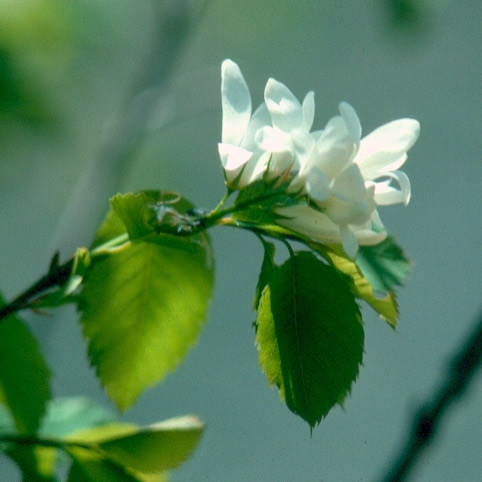Saskatoon
Amelanchier alnifolia

overview
Shrub to small tree, 1-5 m tall, stem smooth, bark dark-grey to reddish, often spreading by rhizomes or rooting branch ends to form dense colonies. Leaves alternate, deciduous, thin, round to oval, regularly toothed mostly on the outer half of the leaf. Flowers white, large (1-2.5 cm across), five petals, 15-20 stamens, showy, in short, drooping, leafy clusters of 3-20 blossoms. Fruit a berry-like pome, dull-red at first, becoming purple to nearly black, with a white bloom (Pojar and MacKinnon, 1994). Photo by Dave Polster.
other names
serviceberry
family
Rosaceae
ecological setting
Rocky shorelines, bluffs, talus slopes meadows, dry to moist open forests. Scattered from low to mid-elevations (Pojar and MacKinnon, 1994).
soil texture
Coarse textured, free-draining (Pojar and MacKinnon, 1994).
nutrients
Nitrogen-medium soils (Klinka et al., 1995).
soil reaction salinity
Moderately acidic to mildly alkaline.
moisture regime
Dry to fresh (Klinka et al., 1995).
shade tolerance
Sun to light shade (Klinka et al., 1995).
successional status
Early seral species on disturbed moist sites. Climax species on dryer sites, particularly southern exposures (Klinka et al., 1995).
bec zone subzone status
BG, BWBS, CDF, CWH, ESSF, ICH, IDF, IWCW, IWHW, MH, MS, PP, PPBG, SAES, SAWS, SBPS, SBS, SBWS, SWB, SWBS (E-Flora BC)
site rehabilitation
Excellent reclamation species. Drought tolerant once established. Good soil stabilization properties. Very adaptable.
wildlife
Fruit eaten by a wide range of birds and mammals. Preferred browsed species for many wild ungulates. Wildlife keystone species.
landscaping
Showy, abundant blossoms. Good fall colour. Attracts wildlife to the urban garden. Use as a single specimen, hedge or background to borders (S. Bastin, pers. comm.). Horticultural varieties have been developed from many prairie species for commercial and garden use (Pojar and MacKinnon, 1994).
first nations
Berries highly regarded by almost all aboriginal groups, particularly in the interior, and were dried into cakes for storage.
other uses
Being grown commercially in prairie Provinces. Saskatoon berries are the second largest fruit crop in Manitoba (anonymous 2, 2001).
flowering time
May to June
fruit ripening time
Late June to early July
seed collection time
mid–July
crop intervals
Annual or three to five years depending on provenance
no seeds per kg
80,025 to 250,885 (Brinkman, 1974)
seed viability
Large per cent is infertile. Sorted, moist-stratified seed germinates at 50–70%. (anonymous 4, no date).
seed storage
Dried seeds will remain viable for up to five years if stored at 5º C (Brinkman, 1974).
fruit seed dormancy treatment
Sterilize seed to prevent mould by soaking in 5–10% H2O2 for 15 minutes. Soak for 24 hours and then cold-stratify for 120 days at 1–6º C. Check regularly after 100 days for germination. Fall sowing also gives good success. Seeds can germinate at 3–5º C but best germination occurs at 24º C day/20º C night. Sow in a sandy soil to a depth of 0.5 cm and mulch until germination. Seedlings prefer light shade after germination. [Fruit/Seed Dormancy and Treatment (Brinkman, 1974, Hudson and Carlson, 1998)]
vegetative propagation
| Method | Success Rate | Time of Collection |
|---|---|---|
| Softwood cuttings | Moderate – good | Before buds set |
| Semi-hardwood cuttings | Moderate – good | Spring to summer (Hosokawa, 2004) |
| Hardwood cuttings | Low | Fall to winter |
| Root cuttings: Take cuttings 0.6 cm diameter x 5 cm long stuck vertically in rows 5 cm apart with the proximal end at soil level and covered with 1.5 cm of perlite. | Good | December to February |
| Suckers: Remove suckers by cutting with a sharp spade. Wash off excess soil, cut back the stem and trim the root system. Plant division in pots, beds or open ground. | Excellent | Early spring |
| Plant division | High | Early spring (Anonymous 1, 2006) |
additional info and photos
For more information and pictures, visit the E-Flora BC website at www.eflora.bc.ca.